Are you a Quiet Speculation member?
If not, now is a perfect time to join up! Our powerful tools, breaking-news analysis, and exclusive Discord channel will make sure you stay up to date and ahead of the curve.
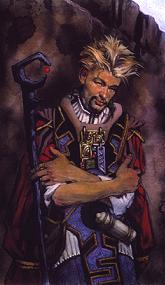 In two straight days of testing, we'd managed to knock out three of the four Great Designer Search 2 finalist's decks, playtesting and reviewing submissions from Ethan Fleischer, Scott Van Essen, and Devon Rule. The final member of this august group, Shawn Main, had just managed to squeak his deck in at the buzzer, so we dutifully rose that Sunday morning, put on a good breakfast, brewed two pots of coffee and sleeved up The Blight.
In two straight days of testing, we'd managed to knock out three of the four Great Designer Search 2 finalist's decks, playtesting and reviewing submissions from Ethan Fleischer, Scott Van Essen, and Devon Rule. The final member of this august group, Shawn Main, had just managed to squeak his deck in at the buzzer, so we dutifully rose that Sunday morning, put on a good breakfast, brewed two pots of coffee and sleeved up The Blight.
If there was a deck that had me most concerned on a sight-unseen basis, it was this one. From what I'd previously gathered, blighting was a mechanic that destroyed permanents on the field. That sounded intriguing but also had the potential to be horribly unfun, especially against decks that weren't part of its set. It might be balanced to be blowing the crap out of your opponent's board if she's blowing the crap out of yours, but what happens when the opponent is playing something else? Do they just watch their board state get ground up with little hope of survival? It was with these concerns in mind that I entered the world of Wodotha. As the deck had arrived nameless, we quickly took to calling it, quite simply, The Blight.
Shawn Main: The Blight
The World: Wodotha. "The Blight descends and the horizon is gone; succumb or soldier on."
The Mechanic: Blighting is a mechanic that is similar to Scott Van Essen's breakout in that it's a bit tricky to grasp at first (especially on paper), but you quickly figure it out and from there on it's quite simple. When blight is triggered, two things happen. First, you look at the board for any and all permanents that have a blight counter placed upon them, and these are destroyed. Next, you put a blight counter on a legal permanent. What constitutes a 'legal permanent' has some variations to it, illustrating some rich design space available to the mechanic. Creatures tend to blight other creatures, Blight Naturalize blights an artifact or enchantment (as you'd expect), and there are a few ways to blight just about anything (such as the Void Sphere, an artifact which blights target permanent). Remember the Ghosts in StarCraft, who would 'paint' a target then call in a nuke strike? This is rather similar: your first blight card 'paints' a target, then your next blight card then nukes the one you painted while painting another.
The Deck: Shawn opted to go with a Black/Green construction that showcased the blight mechanic in a number of different ways, using the common formula of 12 lands each in two colours, 24 creatures and 12 noncreatures. A mana curve of 2-6-6-4-6 (1,2,3,4,5+ CMC) gave the deck plenty of things to do at neary any point in the game and nearly 40% of these creatures interact with blight.
As you might expect, blight doesn't start to make an appearance until the mid-game. Early options like Deathgreeter and Runeclaw Bear offer some early board presence, while a quartet of weenies with interesting abilities disincentivise an opponent from attacking. The Venturesome Gatherer is a two-drop 1/1 elf that lets you draw a card when it dies, while the Gravechatter Rat is similarly a 1/1 rat that forces your opponent to discard upon death. Given that many players exhibit an aversion to discard, something understandable, albeit irrational, the Rat in particular can be an effective stall tactic. Moving into the three-drops, you have the Hungry Vampire, a 2/2 that gets +1/+1 and flying when a critter is fed to it, a weaker but evasive version of Vampire Aristocrat. And that's when you run into the blight critters.
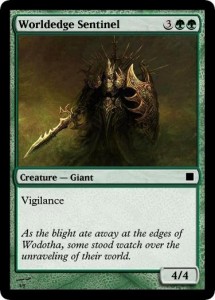 If there's one thing the blight creatures all have in common it's that they trigger a blight before anything else. If there's anything on the board that's been 'painted' then these creatures double as a removal spell as well. The Doom Herald is a 3/1 Horror that blights a creature; simple enough. Then you have the Void Serpent which carries "blighttouch." This means that whenever it deals damage to a creature, then a blight happens (again, destroying anything already painted) and the damaged creature gets a blight counter as well.
If there's one thing the blight creatures all have in common it's that they trigger a blight before anything else. If there's anything on the board that's been 'painted' then these creatures double as a removal spell as well. The Doom Herald is a 3/1 Horror that blights a creature; simple enough. Then you have the Void Serpent which carries "blighttouch." This means that whenever it deals damage to a creature, then a blight happens (again, destroying anything already painted) and the damaged creature gets a blight counter as well.
Moving on to the four-drops, you have two each of the Blightsky Horror and the Bone Courier (the latter a functional reprint of Gravedigger). The Blightsky Horror is a 3/3 body (a good deal for Black) which also has a twist. After its blight resolves, it then puts a blight counter on a flying creature. Making things worse for the doomed target, the Horror also says "Creatures with blight counters on them lose flying." Doomed and grounded? Quelle horreur indeed!
Finally, we arrive at the fat end of the pack, the 5+ costed creatures. Of the six, three of them interact with blight. The three that don't are the Worldedge Sentinel (a 4/4 Green creature with vigilance, of which you get two in the deck), and the rare Purveyor of Corruption. While the Purveyor doesn't get its hands dirty in the messy business of blighting, it certainly reaps a tidy profit from it: whenever an opponent has one of their creatures put into a graveyard, you may pay a black mana and get a 3/3 Horror creature token.
That leaves us with a pair of Omen Vultures and the premium foil rare, Corruption Dragon. The Vultures are a bit of a raw deal: for five mana you only get a wimpy 2/2 flyer, but on the upside they do blight (try and look at it as a kicked Heartstabber Mosquito which makes the pill go down a little easier). What difference does adding a Black mana to the casting cost and upping it a rarity level (from uncommon to rare) make? That takes you from the Vulture to the Dragon, a 5/5 flyer which blights every time it attacks. Quite a contrast!
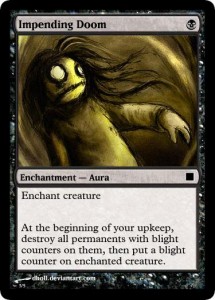 The Support: The noncreature cards in Shawn's deck take on a strong supporting role. You have some mana ramp in Harrowing Horizons (sac a creature, fetch an untapped basic land, and not quite as bad a deal as it first looks when you can 'repurpose' a creature that's about to die anyway) and a pair of [card Fog]Fogs[/card] to blank out incomging damage. There's an equipment card in the form of the Berserker's Dualaxe, which gives a slight power boost and requires that the equipped beater be blocked only by two or more creatures. And finally, you have everything else, all of which involves blight.
The Support: The noncreature cards in Shawn's deck take on a strong supporting role. You have some mana ramp in Harrowing Horizons (sac a creature, fetch an untapped basic land, and not quite as bad a deal as it first looks when you can 'repurpose' a creature that's about to die anyway) and a pair of [card Fog]Fogs[/card] to blank out incomging damage. There's an equipment card in the form of the Berserker's Dualaxe, which gives a slight power boost and requires that the equipped beater be blocked only by two or more creatures. And finally, you have everything else, all of which involves blight.
Blight Suffering is one of the deck's all-stars. For one thing, blight tends to be a slow affair mostly done through the casting of creatures. Blight Suffering is a three-mana Black instant that triggers a blight, then puts a blight counter on a target creature. But wait, there's more! The creature's controller then loses life equal to the creature's toughness. Take that, [card Kozilek, Butcher of Truth]Kozilek[/card]!
Next we have a pair of Impending Dooms. These are cheap creature auras that afflict its target with the Doom status a la Final Fantasy. Once it's on, that creature knows its turns are numbered. Finally, we have a pair of the Blight Naturalizes mentioned above, and a Void Sphere (an artifact which allows for two blight triggers before it dies).
The Playtest: No matter what a deck might look like, there is simply no substitute for putting rubber to the road. At all points during out playtest weekend, we'd had our assumptions challenged once the cards were shuffled. Ethan's evolve deck seemed simple, but it was nuanced. Scott's breakout seemed complicated, but it was simple. Devon's gold deck seemed solid, but it was broken. Would Shawn's deck follow suit? With thoughts of blight counters smashing the landscape like an antimatter Stone Rain, we sleeved up and went to battle.
We had my first snaking suspicion that things were not quite as we'd feared in the first round, when where The Blight beat Kor Armory two games to one. With both games very even affairs (low single-digit life), the decks felt well-balanced against one another. In game one I was able to blight out a Serra Angel to set up the win, but then in game three an Armament Master was able to last several turns without The Blight being able to solve him, until Kor Armory resolved a Conqueror's Pledge, equipped the Master and finished the game.
The deck struggled more against the Boros-aggro Rapid Fire from Worldwake, which had the quickness of white weenie with some burn to punch through. With blight cards tending to congregate at the higher end of the mana curve, I was blown out in the very first game after being swarmed. I lost the second, though I left my opponent clinging to life, and I sqeaked a win in game three. Once blight had the time it needed to set up it could be devastating, but the [card Steppe Lynx]Steppe Lynxes[/card] and [card Kor Skyfisher]Kor Skyfishers[/card] had a vested interest in stopping that from happening, to which they were largely successful.
Round three was the big test, Magic 2011's Stampede of Beasts. This has consistently been the meatgrinder matchup for these GDS2 intro decks, as their bloated-cost creatures typically can't pace the lean, efficient beaters that Green brings. Fate was no less kind to The Blight. Lack of consistent spot removal meant I watched my demise unfold in slow motion in game one as I couldn’t snipe out a Prized Unicorn before it was able to clear my defenders out, 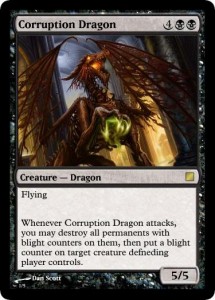 letting the rest of the Green beaters destroy me on the back of an Overwhelming Stampede. I caught a break in game two with an early Blight Dragon, and it was able to give me some control over the board and set up a win. In game three, I was close until a great play sequence from my opponent saw my Dragon get [card Act of Treason]Act of Treasoned[/card], swing in alongside a Spined Wurm, then get [card Fling]flung[/card] to close the game out. In my closing moments, I muttered something perhaps worth noting, "why does it always feel like this deck is a turn or two from going off?" After three rounds of play, The Blight had a pleasingly even record of 4-5.
letting the rest of the Green beaters destroy me on the back of an Overwhelming Stampede. I caught a break in game two with an early Blight Dragon, and it was able to give me some control over the board and set up a win. In game three, I was close until a great play sequence from my opponent saw my Dragon get [card Act of Treason]Act of Treasoned[/card], swing in alongside a Spined Wurm, then get [card Fling]flung[/card] to close the game out. In my closing moments, I muttered something perhaps worth noting, "why does it always feel like this deck is a turn or two from going off?" After three rounds of play, The Blight had a pleasingly even record of 4-5.
If Stampede of Beasts are where tricky-critter decks go to die, Scars of Mirrodin's Phyrexian Poison is the one where they go to get hope. Because infect critters are slightly inefficient compared to regular ones it gives opposing decks a little bit of breathing room. The Blight took two games handily, and only lost one because of my inability to find even a single Forest for almost the entire game. The Blight was riding high but things were about to change.
Staying on the plane for Myr of Mirrodin The Blight wore the 0-3 collar for the first time. The Myr were relatively quick to develop and had solid presence in the skies: two things that The Blight had a hard time coping with. When I asked my opponent to describe their play experience they said they felt like they had to go fishing to cause me pain, setting up intricate sequences of plays rather than just tossing off a Doom Blade. The same experience happened next with the monoblack aggro deck Fangs of the Bloodchief. Our testing was exposing a significant Achilles' Heel for The Blight: it was frighteningly vulnerable to early-game rushes. Things weren't entirely grim, although it did end up going 0-3 against Fangs overall, as one of the games was a swing back where The Blight had the vampires on the ropes. Unfortunately it couldn't quite finish them off and ended up losing from ahead.
The session ended with a run against Scars of Mirrodin's Metalcraft which had a rather unique weapon in its arsenal. The Argent Sphinx was The Blight's worst nightmare: a flying creature which could shake off blight counters almost at will. Still, one of our three games was a marathon session that ran just over half an hour. I kept landing threats and The Blight was able to keep pace in removing them. Neither one of us seemed able to turn the corner and get an edge until the very end. Beyond the fun of the game it was a great sign for the balance of both the deck as well as the mechanic.
The Blight went 7-14 on the day, revealing the misconception that the blight mechanic was overpowered. With submissions by the finalists due the same day I made straight for the computer and composed a report and analysis for Shawn. Here was its conclusion:
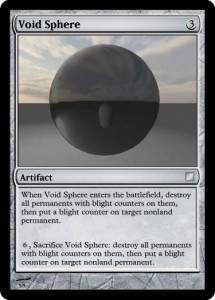 Overall, I enjoyed playing the Blight deck as well as playing against it but we feel it needs some fine-tuning. The mechanic itself is nuanced and perhaps just a point shy of feeling really elegant. I love how it works and the narrow-focus blightings really gave it some flavour. One card blights Artifacts/Enchants, another flying creatures. I think there’s some untapped potential here because no matter how narrow a blighting it still begins by killing anything with a blight counter on it. This means that there’s still synergies amongst them.
Overall, I enjoyed playing the Blight deck as well as playing against it but we feel it needs some fine-tuning. The mechanic itself is nuanced and perhaps just a point shy of feeling really elegant. I love how it works and the narrow-focus blightings really gave it some flavour. One card blights Artifacts/Enchants, another flying creatures. I think there’s some untapped potential here because no matter how narrow a blighting it still begins by killing anything with a blight counter on it. This means that there’s still synergies amongst them.
I wish I had done so earlier but in the second half of our testing I began keeping track of how many things I lost to the blight to see how influential the mechanic was. It was widely variant but I could usually count on losing two permanents a game for an average game. Far from being broken (my initial impression) that put it right on par with intro deck-level removal which was a most reassuring realisation.
Here’s another casual metric. At the end of every match my opponent and I would rate our deck’s performances on a 5-point scale. A rating of ‘3’ meant the deck felt balanced against the other, 1-2 meant it felt weak (very weak, somewhat weak), and 4-5 similarly indicated strong. Both ratings kept very close to 3 for all 21 matches and off-the-cuff I’d say this is the most consistent results we’ve seen.
That means that the Blight deck, whether it wins or loses, still feels like it has intro deck levels of power which is certainly encouraging.
So where does the deck fall short? First, the deck is heavily draw-dependant. Don’t get enough blight cards and you’re going to be at a loss to remove anything at all. It’s undoubtedly a tough balance. You don’t want to sprinkle in a bunch of Doom Blades because that makes it too good at removal when paired with blight. But fundamentally a player does want to feel in control of their deck and blight doesn’t give them the same reassurance.
The other problem it faces is that its creatures tend to be a bit smaller in size. You’ve done well addressing this with the Dragon, the Demon, and the Worldedge Sentinelsthough. Feeling an acute sensation of being outclassed in the red zone might just be a factor of not feeling like you can just up and kill something that’s a threat.
Overall, great job on the whole making the mechanic flavourful and balanced!
As it turned out it did seem our initial fears of an overpowering mechanic were misplaced and the deck did not steamroll its way through the gauntlet; far from it! There was a certain balance inherent in the blight; it was lots of removal, yes, but it never actually killed right away. Instead, you had to paint your threat, then play another blight card to remove it. If you didn't happen to have one on hand you could be in serious trouble.
We've stayed out of the predictions business in the interests of impartiality, and we won't be breaking that. What I can say is that we had a lot of fun running the decks and consider it an honour and a privilege to have been asked by all four of the finalists. Wizards will be announcing their final elimination soon, nd we at Quiet Speculation wish all four of the designers (Ethan, Scott, Devon, and Shawn) the very best of luck as they look for a chance to grab the gold ring of their dream job in both hands.


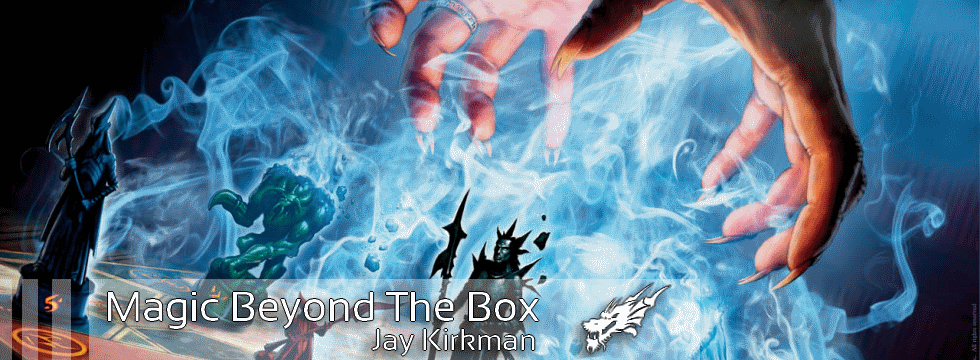


I have to say that I am wondering as to the decklists and functions of some of these cards… I see you referred to a "demon" in your feedback, but I dont think you ever mention that card…
Anyway, I really liked you guys doing this, and I think it was a pretty cool idea to take out the contestants decks and test them against actual precons… reading the game logs was quite interesting.
In fact the card did get mention above, but to be fair I didn't identify it as a 'demon' when I first introduced it (Purveyor of Corruption). My apologies for the confusion, that could certainly have been clearer!
I like the Blight mechanic and deck, and am glad to see that Sean made it to the final round of the GDS. I'm also glad to see it did well in your tests.